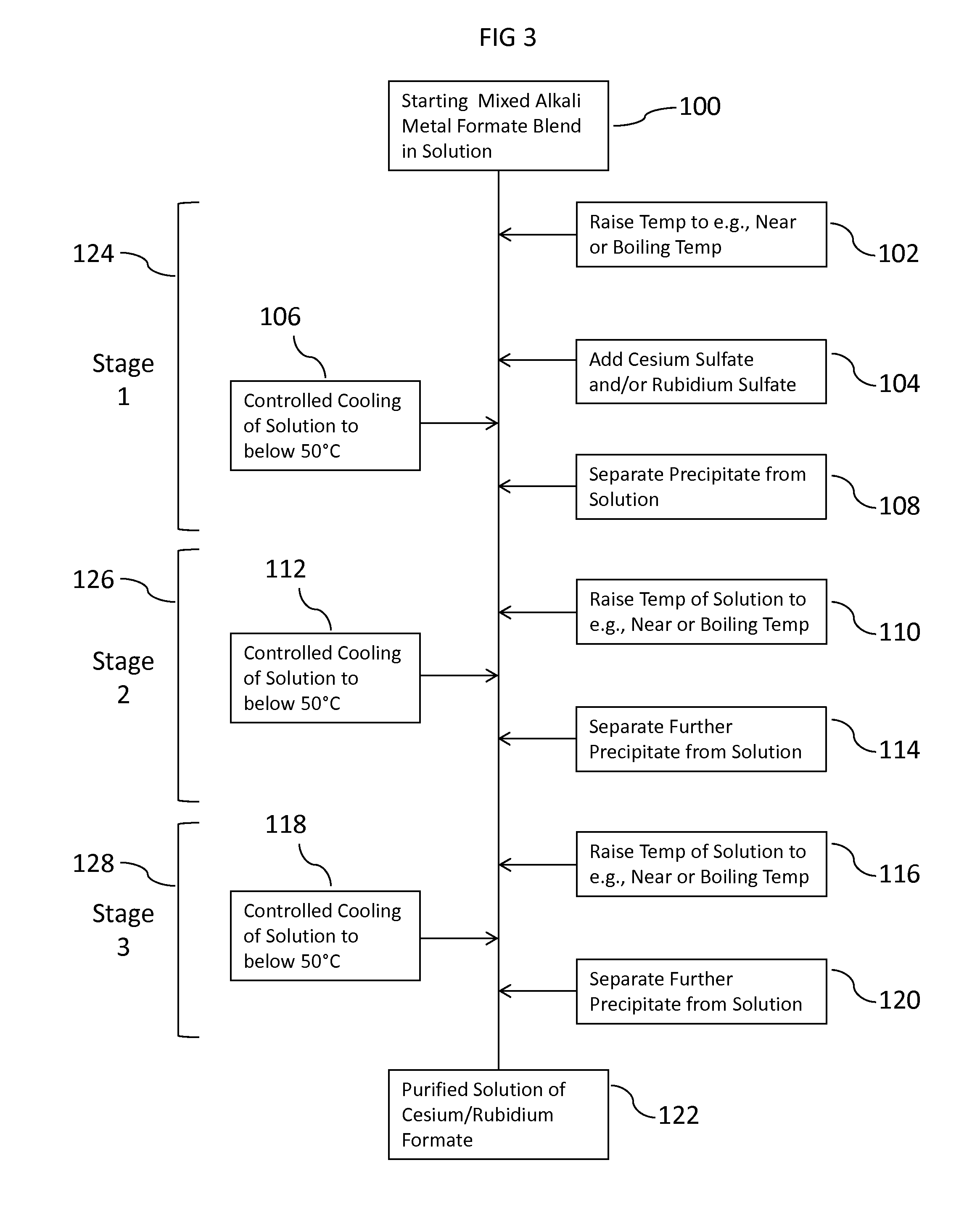Methods To Recover Cesium Formate From A Mixed Alkali Metal Formate Blend
a technology of metal formate and cesium formate, which is applied in the preparation of alkali metal oxides/hydroxides, lithium compounds, carboxylic compounds, etc., can solve the problems of large inventory, difficult to provide this blend to a subsequent user, and large inventory of rather unu. , to achieve the effect of efficient and inexpensiv
- Summary
- Abstract
- Description
- Claims
- Application Information
AI Technical Summary
Benefits of technology
Problems solved by technology
Method used
Image
Examples
example 1
Cs2SO4 Route with Oil-Field Recovered Cs,K Formate Brine
[0209]A sample (of equal amount) was taken from each of ten totes of a returned 1.82 SG mixed Cs,K formate oil-field brine to make a combined sample for testing (referred to as the ‘sample’). The brine had already been filtered. Confirmed by a sample measurement, the specific gravity of the sample was 1.82 SG. By volume, this suggested a blend of 39.6832% by volume of 2.20 SG Cs Formate solution, and 60.3168% by volume of 1.57 SG K Formate solution. Stock Cs Sulfate solution, nominally 50% by wt, with a 1.6758 SG and solution pH of 8.02 was chosen as the Cs2SO4 reactant solution.
[0210](Stage 1) 200 ml of the mixed formate brine was added to a 500 ml glass beaker and placed on a heated stirrer plate. The agitated sample was heated to 80 to 100° C. While maintaining this temperature range, 125 ml of the cited stock Cs Sulfate solution was added. The wetted graduated cylinders to measure out the two solutions were flushed clean wi...
example 2
Cs2SO4 Route with a Lab Prepared Virgin Cs,K Formate Brine
[0217]In this Example, a Cs,K mixed formate brine is lab prepared in its virgin state, without addition of any oil-field additives. This removes the potential issue of additives precipitating during the Cs,K mixed brine separation and restoration process. A standard, buffered, mixed formate brine was prepared using virgin 2.20 SG Cesium Formate solution and a virgin 1.57 SG K-Formate solution. The 50:50 (% by volume) blend formulation was prepared for the separation and restoration trial.
[0218]125 ml Cs Formate and 125 ml K Formate were measured and mixed in a 500 ml glass Pyrex beaker, and placed on a heated and agitated stirrer plate. The blended formate brine measured 1.88 SG, as aligned with the blending tables.
[0219]Stock Industrial Grade 50 wt % Cs Sulfate solution was chosen for the trial. The 1.67 SG stock 50% Cs Sulfate solution contained about 140,000 ppm of Sulfate, including an accounting for the sulfate from othe...
example 3
HCO3 / CO3 Route
[0230]In a 500 ml glass beaker, 200 ml of a mixed Cs, K Formate brine blend, returned from use in the oil field, was heated to 80° C. on an agitated heated stirrer plate. While maintaining a temperature of 80 to 100° C. throughout the addition, 60 ml of 2.3 SG 68 wt % Cs2CO3 solution was added to the beaker. The mixture was heated beyond its observed initial boiling point of 120° C., with increased heating to an intermediate boiling point of about 132° C. The sample was then agitated and cooled to 15 to 30° C. No filtering occurred (but could) but it was decided to heat further to achieve further precipitation. The solution was further heated, with agitation, to a boiling point of about 141.5° C. As done previously, the sample was allowed to cool on a separate agitated stirrer plate to near room temperature (about 25° C.), and then allowed to settle for observation of crystal bed level. A precipitate (solids phase) was observed, and appeared consistent with a potassium...
PUM
| Property | Measurement | Unit |
|---|---|---|
| temperature | aaaaa | aaaaa |
| boiling point | aaaaa | aaaaa |
| wt % | aaaaa | aaaaa |
Abstract
Description
Claims
Application Information
 Login to View More
Login to View More - R&D
- Intellectual Property
- Life Sciences
- Materials
- Tech Scout
- Unparalleled Data Quality
- Higher Quality Content
- 60% Fewer Hallucinations
Browse by: Latest US Patents, China's latest patents, Technical Efficacy Thesaurus, Application Domain, Technology Topic, Popular Technical Reports.
© 2025 PatSnap. All rights reserved.Legal|Privacy policy|Modern Slavery Act Transparency Statement|Sitemap|About US| Contact US: help@patsnap.com



